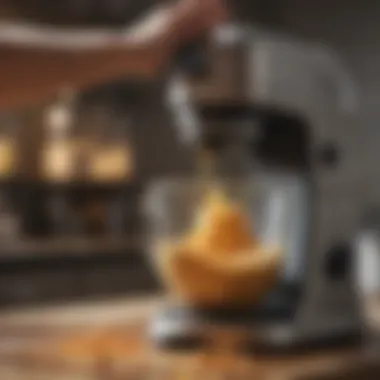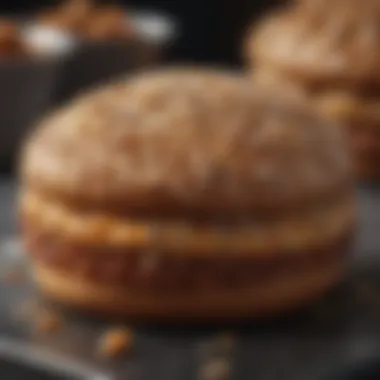The Role of Blenders in Enhanced Baking Techniques


Intro
Baking is both an art and science. Understanding the tools available can greatly impact results. One such tool that has gained prominence is the blender. While we often associate blenders with smoothies and soups, their role in baking is equally vital. This section aims to outline the importance of blenders in the baking process, focusing on how they can enhance the quality, texture, and overall consistency of baked goods.
Blenders come equipped with various speeds and settings that allow for precise control during the mixing process. This is beneficial for a range of recipes from cakes to breads. Unlike manual methods, using a blender can achieve a uniform mixture faster, resulting in more reliable outcomes. For novice bakers, this efficiency can be a game-changer, promoting confidence in the kitchen.
Moreover, blenders can facilitate a variety of techniques, such as emulsifying ingredients or incorporating air into batters. This can lead to lighter, fluffier baked goods. As this article progresses, we will explore how to select the right blender, its specific applications in various baking scenarios, and tips for maintaining this invaluable kitchen equipment.
Understanding Blenders in Baking
Blenders play a significant role in the baking process. They can enhance both efficiency and consistency in creating a wide range of baked goods. By integrating a blender into your baking routine, you can streamline the mixing process, allowing for quicker preparation times without sacrificing quality. Understanding how different types of blenders function can aid bakers in selecting the most suitable tool for their needs.
Definition and Purpose
A blender is an appliance designed to mix or emulsify ingredients. In baking, it serves several purposes including mixing batter, blending dough, or creating smooth fills for pastries. The versatility of a blender allows for the incorporation of various ingredients in a uniform manner. This contributes to the overall quality and texture of baked goods, as well as providing ease of use for bakers of all skill levels.
Different Types of Blenders
Blenders come in various forms, each with unique features optimized for specific tasks in baking. The three main types include countertop blenders, handheld immersion blenders, and specialized baking blenders.
Countertop Blenders
Countertop blenders are powerful machines typically used for larger quantities of ingredients. Their key characteristic is their strong motor, which can handle dense mixtures. This makes them ideal for tasks like mixing cake batters or blending thicker doughs. A notable advantage of countertop blenders is their versatility; they can also make smoothies and soups, making them a popular choice in many kitchens. However, they can be bulky and take up valuable counter space.
Handheld Immersion Blenders
Handheld immersion blenders are compact and easy to use. They are designed to blend ingredients directly within a bowl or pot, providing convenience for small mixing tasks. The key aspect of immersion blenders is their portability and ease of storage, as they require less space compared to countertop models. They are particularly useful for tasks like emulsifying dressings or mixing batters. Yet, their power might not suffice for denser mixtures, which is a disadvantage when preparing thicker doughs.
Specialized Baking Blenders
Specialized baking blenders are designed specifically for the needs of bakers. They often have preset functions tailored for various baking tasks, such as whisking egg whites or kneading dough. The unique feature of these blenders is their ability to provide optimal speeds and settings for delicate mixtures. This ensures that even the most intricate recipes can be executed with precision. However, their specialized nature can sometimes lead to a higher price point compared to standard models.
In summary, understanding the different types of blenders can empower bakers to make informed choices that improve their baking experiences. The right blender not only enhances efficiency but also contributes to achieving consistent and desirable results.
Advantages of Using a Blender in Baking
The use of a blender in baking is more than just a matter of convenience. It brings many advantages that enhance the overall baking experience, making it invaluable for both amateur bakers and professional chefs alike. Utilizing a blender can significantly impact how ingredients are mixed, the textural quality of the finished product, and even the time spent in the kitchen. Understanding these benefits provides valuable insight into why a blender is an essential tool in the baking process.
Efficiency in Mixing
A blender offers a level of efficiency in mixing that traditional methods cannot match. The powerful motor and sharp blades allow ingredients to be combined rapidly and uniformly. This efficiency is particularly evident in recipes that demand thorough blending, such as cake batters and pancake mixes. With a blender, bakers can quickly achieve a homogeneous mixture, which helps maintain even distribution of ingredients throughout the batter. It can reduce the physical effort and time required compared to manual mixing methods.
Consistency in Texture
Another key advantage of using a blender is the consistency it brings to various baked goods. The continuous blending action ensures that ingredients are uniformly incorporated, leading to a smoother texture. This is particularly important in making delicate cakes or smooth pastry creams, where texture can directly influence the final product. When using a blender, the risk of lumps and inconsistencies decreases, resulting in a more refined outcome.
Time-Saving Benefits
In today's fast-paced world, time efficiency is crucial. A blender can streamline the baking process significantly. Preparing ingredients that typically require extensive mixing time can now be done in a fraction of the usual time. For instance, creating a batter that traditionally requires several minutes of hand mixing can often be accomplished in under a minute with a blender. This time-saving feature can be particularly beneficial for those who bake frequently or need to prepare items quickly for gatherings and events.
In summary, using a blender in baking offers enhanced efficiency, improved texture consistency, and crucial time-saving benefits. Embracing this tool can elevate both the quality and speed of the baking process, making it a smart choice for any kitchen.


Blending Techniques for Baking
The techniques used for blending in baking can significantly influence the outcome of baked goods. Proper blending ensures that ingredients combine efficiently, ultimately enhancing the texture and flavor of the final product. Understanding the nuances of different blending methods is essential for both amateur bakers and seasoned professionals. Failing to utilize the right technique can result in inconsistencies, affecting everything from the rise of cakes to the density of muffins.
Preparing Ingredients for Blending
Before starting to blend, it is vital to prepare ingredients appropriately. This involves measuring them accurately and, in some cases, pre-mixing dry ingredients to ensure uniformity. For example, combining flour, baking powder, and salt in a bowl before adding to the blender can lead to better distribution. Another consideration is to bring the ingredients to room temperature, especially for items like eggs and dairy. This small adjustment helps achieve a smoother batter.
Speed Settings and Their Importance
Understanding speed settings on a blender can maximize effectiveness in baking. Different speeds serve specific purposes, tailoring the blending process to the requirements of various recipes.
Low Speed for Mixing
Using a low speed is essential for initial mixing. This setting allows for thorough blending without aerating unnecessarily, which can happen if the mixture is whipped too aggressively. Low speed ensures gentle incorporation of ingredients, reducing the risk of lumps. It facilitates an even distribution of flavors while maintaining the structure.
Key characteristic: Low speed provides controlled blending, making it a popular choice for many bakers.
Unique feature: This speed prevents over-mixing, which is crucial in recipes like muffins where a delicate crumb is desired. The advantage of using low speed is its ability to maintain the integrity of sensitive ingredients while still achieving a homogeneous mixture.
High Speed for Emulsifying
High speed comes into play when emulsifying ingredients such as oils into batters. Emulsification is necessary for creating smooth textures in batters and mixtures. High speed blends quickly, breaking down ingredients effectively and creating a uniform mix.
Key characteristic: This method achieves thorough integration of liquids and solids.
Unique feature: High speed allows for the formation of stable emulsions, essential in recipes requiring a harmonious blend of fats and liquids. An important note is that using too high a speed can lead to over-aeration, which may not be suitable for some baked goods.
Pulse Function Usage
The pulse function on blenders serves a distinct purpose in baking. It allows for short bursts of power, giving bakers control over the blending process. This is particularly useful for achieving specific textures or for breaking down ingredients without complete liquefaction. The pulse setting can help integrate chunky elements like nuts or fruit into a batter while maintaining their structure. Understanding when and how to use the pulse function efficiently can lead to improved results in various baked goods.
Common Baked Goods Benefiting from Blender Use
The use of blenders in baking offers significant advantages, particularly in producing common baked goods. Their ability to integrate ingredients effectively contributes to improved texture and consistency, essential elements of high-quality baking. This section explores various types of baked goods that greatly benefit from the use of a blender. Each subsection will highlight how blenders enhance the preparation process and the final results, ensuring optimal flavor and texture.
Cake Batters
Cake batters require precise mixing to achieve the right consistency. A blender allows for smooth integration of dry and wet ingredients. This makes it easier to reach the desired batter consistency without over-mixing, which can lead to tough cakes. The speed settings on a blender enable a careful balance of power and gentleness, preventing the incorporation of too much air, which is crucial for lighter cakes.
Muffins and Quick Breads
Muffins and quick breads can be tricky. Using a blender simplifies the process of combining ingredients without overworking the batter. The pulse function is particularly useful here; it helps you mix just enough to moisten the dry ingredients. This technique results in the tender crumb texture that is characteristic of well-made muffins. Additionally, using a blender can ensure that mix-ins like fruits or nuts are evenly distributed throughout the batter.
Pancake and Waffle Mixes
For pancake and waffle mixes, a blender offers rapid preparation. Combining ingredients in a blender minimizes clumps and promotes uniformity. This results in a batter that cooks evenly, promoting a consistent rise and texture in the finished product. Furthermore, the quick blending process saves time, allowing for faster breakfasts.
Pastry Creams and Fillings
When making pastry creams or fillings, blenders prove essential for achieving smooth, emulsified mixtures. The precise control over mixing speed ensures that ingredients like egg yolks and milk heat evenly without forming lumps. Blenders can also integrate butter and flavorings seamlessly into the final product, ensuring rich and creamy textures that elevate pastries and desserts.


The application of blenders in baking not only streamlines the process but also enhances the quality of basic baked goods, leading to superior results.
In summary, integrating a blender into the preparation of common baked goods results in efficiency and consistency. Understanding how to utilize the right techniques can significantly impact the baking experience.
Selecting the Right Blender for Baking
Choosing the right blender is a critical decision for anyone serious about baking. The right appliance can significantly impact your mixing efficiency and the final quality of your baked goods. Given the diverse types of blenders available, understanding the specific needs of your baking tasks can help in making an informed selection. This ensures you not only get the performance you desire but also enhances your overall baking experience.
Power and Performance Factors
When considering a blender, one of the first factors to examine is power. The wattage of the motor often correlates with the blender's ability to handle various mixing tasks. For instance, a blender with a higher wattage, like the Vitamix 5200, can blend tougher ingredients or larger batches of batter more effectively.
Performance is equally crucial. Speed settings allow for precise control during blending. A powerful blender will typically have multiple speeds, enabling bakers to adjust the consistency suitable for different recipes, whether it's a thick dough or a runny batter. Moreover, check the efficiency of the blades. High-performance stainless steel blades can better handle hard ingredients, especially in recipes that require thorough mixing.
Capacity Considerations
The capacity of the blender is another vital aspect to consider. Depending on the volume of baking you do, you may need a larger or smaller container. For small batches, a standard 48-ounce blender might suffice. However, if you often prepare bigger quantities, a larger capacity blender, such as the Blendtec Designer 725 with a 90-ounce jar, is more suitable. This avoids the need for multiple batches, saving time and ensuring uniform mixing.
Additionally, consider the shape of the blender jar. Tall and narrow jars might be better for liquids, while wider ones can be ideal for thicker mixtures. Selecting the right size and shape can make a significant difference in achieving the desired results in your baking process.
Durability and Material Quality
The durability of the blender affects its longevity and overall value. Blenders constructed from high-quality materials, like BPA-free plastic or glass, are generally more robust compared to cheaper alternatives. Glass jars, while heavier, are often easier to clean and more resistant to scratching.
Check also the warranty offered by the manufacturer. A longer warranty period can be an indicator of the confidence the brand has in its product durability. Investing in a more robust blender may initially seem costly, but it can save you money and trouble in the long run if it lasts through years of baking.
Selecting the right blender is not just about preference; it's about understanding your specific baking needs and aligning them with the functionalities of the appliance.
In summary, evaluating power, capacity, and durability will guide you in selecting a blender that not only meets but exceeds your baking expectations.
Maintenance and Care of Blenders in Baking
Proper maintenance and care of blenders is critical for anyone serious about baking. A well-kept blender not only lasts longer but also ensures that any baked goods created remain consistent and of high quality. When blenders are used frequently, residues from various ingredients can accumulate, which can impact the performance over time. Therefore, it's important to establish a routine for maintaining these appliances.
Cleaning Techniques
Cleaning blenders can be straightforward if done regularly. Each part should be cleaned immediately after use to prevent buildup of food particles. Here are effective cleaning techniques:
- Disassemble the Blender: Always separate the blender jar, blades, and lid from the base. This allows for thorough cleaning of all parts.
- Manual Washing: Use warm soapy water and a soft sponge to gently wipe the components. Avoid abrasive sponges that can scratch surfaces.
- Blender Cleaning Method: Fill the blender halfway with warm water and add a drop of dish soap. Blend on a low setting for a few seconds, then rinse several times to remove any soap residue. This is particularly useful for tough stains or odors.
- Sanitize the Components: Occasionally, use a vinegar-water solution to help sanitize the blades and jars, ensuring that any lingering smells or residues are effectively eliminated. Rinse again with clean water after sanitizing.
Keeping a blender clean will not only maintain its performance, but also ensure food safety during baking endeavors.
Storage Tips
Storing the blender properly is another essential aspect of maintenance. How you store your blender can extend its lifespan and protect it from damage. Here are some tips:
- Find a Dry Space: Always store the blender in a dry area of the kitchen to avoid moisture build-up, which can affect electrical components.
- Keep Components Together: If space allows, store the blender jar and lid on top of its base, so they stay together and are easy to access when needed.
- Cord Management: Keep the power cord neatly arranged to avoid tangling or damage. Using a tie or Velcro strap can help maintain a tidy workspace.
- Avoid Stacking Heavy Items: Do not place heavy items on top of the blender, as this can cause damage to the electrical components or the jar.
"The combination of effective cleaning and proper storage ensures your blender operates at peak performance, enhancing your baking experience."
In summary, maintaining and caring for blenders is essential for efficient baking. Understanding the best cleaning techniques and storage practices can greatly contribute to your success in the kitchen. With a bit of effort and attention, bakers can enjoy the benefits of a well-functioning blender for many years.


Innovative Uses of Blenders Beyond Baking
Blenders are versatile tools in the kitchen, and their applications extend far beyond baking. Understanding these innovative uses can significantly enhance culinary experiences. This article segment highlights important aspects of how blenders can facilitate various food preparations. Recognizing these benefits can optimize the overall cooking process, contributing to efficiency and quality in meal preparation.
Creating Sauces and Dressings
Utilizing a blender for sauces and dressings offers considerable advantages. Rather than mixing by hand or using alternative tools, a blender can achieve smoother, more uniform consistencies. For example, combining ingredients like herbs, oils, and vinegars for salad dressings is simpler and more effective in a blender.
- Texture: The powerful blades ensure that all ingredients blend thoroughly, eliminating any grit from herbs or spices.
- Flavor Fusion: Blending allows for an even distribution of flavors. Ingredients emulsify well, particularly in vinaigrettes, which leads to a richer taste.
- Time Efficiency: Preparing sauces in a blender is much faster. Just add ingredients, blend, and serve, saving valuable time in food preparation.
- Examples of Sauces: Common sauces that benefit from blending include pesto, hollandaise, and marinara.
"A blender not only simplifies sauce preparation but also enhances the flavor profiles significantly through thorough mixing and emulsification."
Making Smoothies and Beverages
Going beyond the realm of solid cooking, blenders are essential for creating smoothies and beverages. This function is particularly beneficial for health enthusiasts.
- Fresh Ingredients: Using a blender allows for the incorporation of various fruits, vegetables, and proteins. It encourages healthier choices by making it easy to consume necessary nutrients in one drink.
- Customization: Personalizing smoothies is effortless in a blender. Ingredients can be adjusted according to dietary needs or flavor preferences, ensuring a tailored experience.
- Quick Preparation: Similar to sauces, beverages require minimal time. Simply toss ingredients in and blend until smooth. This efficiency makes it suitable for busy mornings or post-workout recovery.
- Popular Smoothie Recipes: Green smoothies, berry blends, and protein shakes are all quick and effective uses of a blender in beverage preparation.
In summary, understanding the innovative uses of a blender beyond baking opens a realm of possibilities. Blending sauces and beverages not only enhances flavor and texture but also contributes to efficient meal preparation. For home cooks and culinary enthusiasts, leveraging this tool can substantially elevate quality in various cooking pursuits.
Expert Insights on Blender Use in Baking
Exploring the insights from experts on blender use in baking is essential for both novice and experienced bakers. The role of blenders transcends mere convenience; they significantly improve the efficiency and quality of baking processes. Expert opinions can provide a deeper understanding of optimal blender usage, different techniques suitable for various baked goods, and invaluable tips on maximizing blender capabilities.
Chef Recommendations
Professional chefs note that choosing the right blender can enhance baking experience significantly. They recommend specific models that are robust and versatile. For instance, a high-powered Vitamix blender is preferred for its ability to handle thick batters and emulsify ingredients quickly. Chefs advise home bakers to consider factors like the blender's wattage, as a more powerful motor can efficiently blend denser ingredients.
Additionally, chefs suggest using the right attachments for specific tasks. A whisk attachment can introduce air into cake batters, promoting fluffiness. Similarly, a chopping blade may be effective for preparing fruits or nuts intended for inclusion in muffins or pancakes. Understanding these specific usability insights can elevate the overall baking process, allowing for better texture and taste in finished products.
Common Mistakes to Avoid
In the realm of blender use for baking, several common mistakes can hinder baking success. One prevalent error is overloading the blender. Blending too much at once can lead to uneven mixtures, causing inconsistent textures in the final product. It's prudent to blend in smaller batches to achieve the desired results.
Another mistake lies in misjudging ingredient preparation. Bakers might not cut larger ingredients down to size before placing them in the blender. This oversight can damage the blades or lead to uneven blending. Properly preparing ingredients leads to more efficient blending, ensuring everything gets mixed thoroughly.
Furthermore, ignoring the blender’s speed settings can alter the quality of mixes. For example, using a high speed for a simple cake batter can result in overmixing, affecting the structure once baked. Understanding the right speed for particular tasks is crucial.
"The key to successful baking is not just the ingredients used but also the proper techniques and tools. A good blender is invaluable in achieving the right consistency and texture in your baked goods." - A renowned pastry chef.
In summary, expert insights on blender use in baking encapsulate the advice of chefs and baking professionals. Their recommendations and cautionary notes concerning common pitfalls can significantly assist anyone aiming to elevate their baking skills. By integrating blenders into the baking process thoughtfully, bakers can improve both their results and experience.
End
In wrapping up the exploration of blenders in baking, it is crucial to recognize their significant role in modern culinary practices. The advantage of incorporating a blender into the baking process not only simplifies texture enhancement but also promotes greater consistency across a multitude of recipes. As we discussed, blenders can streamline various aspects of baking, leading to more enjoyable experiences for both novice and skilled bakers.
Blenders facilitate quick mixing, which can result in saving precious time, especially in a busy kitchen environment. This efficiency does not compromise quality; instead, it often enhances it, enabling precise control over the mixing process. Consequently, this results in better distribution of ingredients, which is vital for achieving desired outcomes in different baked goods.
When choosing a blender, considerations such as power and performance, as well as durability, are paramount. Each type of blender available—from countertop models to specialized baking options—offers unique functionalities suited to different baking needs. Being informed about these distinctions ensures that bakers can select the most appropriate equipment for their tasks.
Additionally, the maintenance and care of blenders play a significant role in this equation. Regular cleaning and proper storage not only extend the lifespan of these appliances, but they also contribute to food safety, preventing cross-contamination.
Finally, the insights shared by experts in the field serve as valuable advice that can help individuals avoid common pitfalls associated with blender use in baking. Understanding what to do and what to avoid can lead to successful outcomes in baking projects.
The integration of blenders into baking serves as a testament to the advancement of kitchen technology, constantly improving the way we create and enjoy baked goods. With efficiency, consistency, and quality in mind, embracing these tools can elevate any baking endeavor, satisfying both culinary aspirations and palate preferences.
"Emphasizing technology in baking helps home chefs achieve precision and fun outcomes while mitigating challenges traditionally associated with baking."
In summary, the importance of a blender in baking is manifold—its impact reaches far beyond mere convenience, shaping delightful baking experiences that resonate with both taste and texture.



